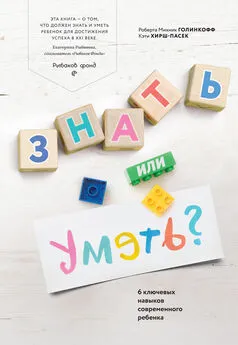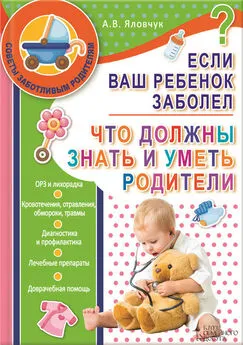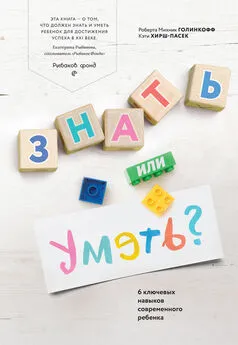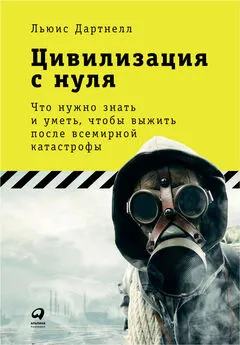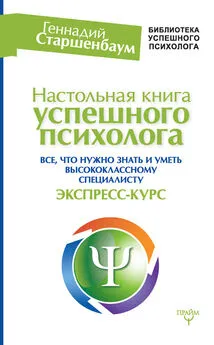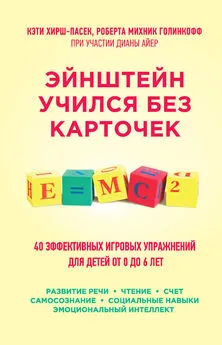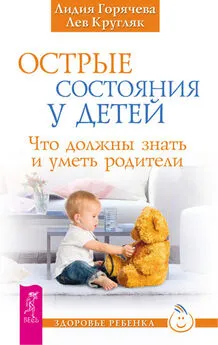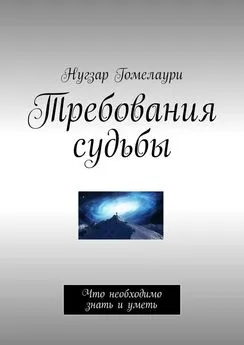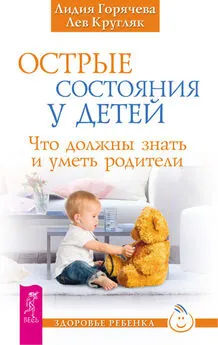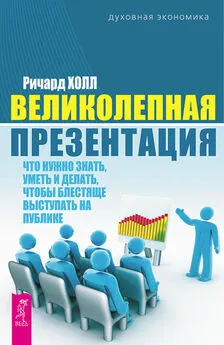Роберта Голинкофф - Знать или уметь?
- Название:Знать или уметь?
- Автор:
- Жанр:
- Издательство:Манн, Иванов и Фербер
- Год:2018
- Город:Москва
- ISBN:978-5-00100-981-8
- Рейтинг:
- Избранное:Добавить в избранное
-
Отзывы:
-
Ваша оценка:
Роберта Голинкофф - Знать или уметь? краткое содержание
Знать или уметь? - читать онлайн бесплатно ознакомительный отрывок
Интервал:
Закладка:
250
Sara. (n.d.). I used to believe: The childhood beliefs site [Web log message]. См. здесь: www.iusedtobelieve.com/animals/, абзац 17.
251
Operator Lady. (n.d.). I used to believe: сайт о том, во что верят дети [сообщение на сайте]. См. здесь: www.iusedtobelieve.com/science/telephones/, абзац 7.
252
Major Dan. (1 августа 2015). 10 famous bridge collapses. History & Headlines. См. здесь: www.historyandheadlines.com/10-famous-bridge-collapses/.
253
Kohn, D. (16 мая 2015). Let the kids learn through play. The New York Times. См. здесь: www.nytimes.com/2015/05/17/opinion/sunday/let-the-kids-learn-through-play.html, абзац 4.
254
Newman, J. (1 октября 2000). 20 of the greatest blunders in science in the last 20 years. Discover. См. здесь: discovermagazine.com/2000/oct/featblunders/.
255
Karmiloff-Smith, K. (1992). Beyond modularity. Cambridge, MA: MIT Press.
256
Shonkoff, J.A. (2011). Building the brain’s “air traffic control” system: How early experiences shape the development of executive function. См. сайт Harvard University Center on the Developing Child: developingchild.harvard.edu/resources/building-the-brains-air-traffic-control-system-how-early-experiences-shape-the-development-of-executive-function/, с. 1.
257
Rimm-Kaufman, S.E., Pianta, R.C., & Cox, M.J. (2000). Teachers’ judgment of problems in the transition to kindergarten. Early Childhood Research Quarterly, 15, 147–166. dx.doi.org/10.1016/S0885-2006(00)00049-1.
258
McClelland, M.M., Cameron, C.E., Connor, C.M., Farris, C.L., Jewkes, A.M., & Morrison, F.J. (2007). Links between behavioral regulation and preschoolers’ literacy, vocabulary, and math skills. Developmental Psychology, 43, 947–959. dx.doi.org/10.1037/0012–1649.43.4.947.
259
Blair, C., & Razza, R.P. (2007). Relating effortful control, executive function, and false belief understanding to emerging math and literacy ability in kindergarten. Child Development, 78, 647–663. dx.doi.org/10.1111/j.1467–8624.2007.01019.x.
260
Alloway, T.P., & Alloway, R.G. (2010). Investigating the predictive roles of working memory and IQ in academic attainment. Journal of Experimental Child Psychology, 106, 20–29. dx.doi.org/10.1016/j.jecp.2009.11.003.
261
Diamond, A., Barnett, W.S., Thomas, J., & Munro, S. (30 ноября 2007). Preschool program improves cognitive control. Science, 318, 1387–1388. dx.doi.org/10.1126/science.1151148.
262
Goldstein, T., & Winner, E. (2012). Enhancing empathy and theory of mind. Journal of Cognition and Development, 13, 19–37. dx.doi.org/10.1080/15248372.2011.573514.
263
Hardiman, M., Magsamen, S., McKhann, G., & Eilber, J. (2009). Neuroeducation: Learning, arts, and the brain: Findings and challenges for educators and researchers from the 2009 Johns Hopkins University Summit. New York, NY: Dana Press.
264
Anderson, Z. (11 октября 2011). Rick Scott wants to shift university funding away from some degrees. Sarasota Herald-Tribune. См. здесь: politics.heraldtribune.com/2011/10/10/rick-scott-wants-to-shift-university-funding-away-from-some-majors/.
265
Hirsh-Pasek, K., Zosh, J., Golinkoff, R.M., Gray, J., Kaufman, J., Robb, M. (2015). Harnessing the science of learning to promote real educational apps. Psychological Science in the Public Interest, 16, 3–34. dx.doi.org/10.1177/1529100615569721.
266
Hirsh-Pasek, K., Golinkoff, R.M., Singer, D., Berk, L. (2009). A mandate for playful learning in preschool: Presenting the evidence. New York, NY: Oxford University Press.
267
Pashler, H., McDaniel, M., Rohrer, D., & Bjork, R. (2008). Learning styles concepts and evidence. Psychological Science in the Public Interest, 9, 105–119. dx.doi.org/10.1111/j.1539–6053.2009.01038.x.
268
Penn Medicine. (26 февраля 2014). New study suggests evidence-based narratives help emergency medicine doctors improve recall of opioid prescribing guidelines. См. здесь www.uphs.upenn.edu/news/News_Releases/2014/02/meisel/.
269
Kilaru, A.S., Perrone, J. Auriemma, C.L. Shofer, F.S., Barg, F.K., Meisel, Z.F. (2014). Evidence-based narratives to improve recall of opioid prescribing guidelines: A randomized experiment. Academic Emergency Medicine, 21, 244–249. dx.doi.org/10.1111/acem.12326.
270
Hanford, E. (1 января 2012). Physicists seek to lose the lecture as teaching tool. См. сайт National Public Radio: www.npr.org/2012/01/01/144550920/physicists-seek-to-lose-the-lecture-as-teaching-tool, абзац 11.
271
Hanford, E. (1 января 2012). Physicists seek to lose the lecture as teaching tool. См. сайт National Public Radio: www.npr.org/2012/01/01/144550920/physicists-seek-to-lose-the-lecture-as-teaching-tool, абзац 20.
272
Mazur, E. (2 января 2009). Farewell, lecture? Science, 323, 50–51.
273
Гладуэлл М . Гении и аутсайдеры. Почему одним все, а другим ничего?М.: Манн, Иванов и Фербер, 2016.
274
Grossman, L. (13 ноября 2008). Outliers: Malcolm Gladwell’s success story. Time. См. здесь: content.time.com/time/magazine/article/0,9171,1858880-1,00.html.
275
Chi, M.T.H. (1978). Knowledge structure and memory development. In R. Siegler (Ed.), Children’s thinking: What develops? (pp. 73–96). Hillsdale, NJ: Erlbaum.
276
Chi, M.T.H. (2006). Two approaches to the study of experts’ characteristics. In K.A. Ericsson, N. Charness, P. Feltovich, & R. Hoffman (Eds.), Cambridge handbook of expertise and expert performance (сс. 121–130). Cambridge, MA: Cambridge University Press.
277
The McGraw Center for teaching and Learning. (n.d.). Novice v. expert problem solvers. См. сайт Принстонского университета: www.princeton.edu/mcgraw/library/for-students/problem-solvers/.
278
Фервей — участок с травой средней длины, занимающий большую часть игрового поля.
279
Ericsson, K.A. (Ed.). (2009). Development of professional expertise. New York, NY: Cambridge University Press.
280
Vygotsky, L. (1978). Mind in society: The development of higher mental processes. Cambridge, MA: Harvard University Press.
281
Wood, D. (1980). Teaching the young child: Some relationships between social interaction, language, and thought. In D. Olson (Ed.), The social foundation of language and thought (pp. 280–296). New York, NY: Norton.
282
Бар-мицва — день, когда по еврейским законам подросток становится взрослым (у мальчиков — 13 лет, у девочек — 12). Обычно в такой день ребенку устраивают большой праздник.
283
Edersheim, E.H. (2006). The definitive Drucker. New York, NY: McGraw-Hill.
284
Пирекс — посуда из жаропрочного стекла.
285
Krishnamurti, J. (n.d.). Jiddu Krishnamurti quotes. См. сайт BrainyQuote.com: www.brainyquote.com/quotes/quotes/j/jiddukrish395484.html.
286
Луддиты — группа английских рабочих, в начале 1800-х годов протестовавших против изменений, которые повлек за собой промышленный переворот, и считавших, что их занятости угрожает опасность. Часто протест выражался в разрушении машин и оборудования.
287
Benjamin, N., Haden, C.A., & Wilkerson, E. (2010). Enhancing building, conversation, and learning through caregiver — child interactions in a children’s museum. Developmental Psychology, 46, 502–515. dx.doi.org/10.1037/a0017822.
288
Haden, C.A. (2010). Talking about science in museums. Child Development Perspectives, 4, 62–67. dx.doi.org/10.1111/j.1750–8606.2009.00119.x.
289
Аристотель . Этика. («Никомахова этика» и «Большая этика»). М.: АСТ, 2010.
290
Челси — здесь имеется в виду исторический квартал в западной части Нижнего Манхэттена, Нью-Йорк.
291
Simon, M.H. (продюсер), Simon, M.H., Makar, M. (режиссеры). (2007). Nursery university [Motion picture]. United States: Docurama.
292
Bruni, F. (2015). Where you go is not who you’ll be: An antidote to the college admissions mania. New York, NY: Grand Central.
293
Halpern, D.F. (1998). Teaching critical thinking for transfer across domains: Dispositions, skills, structure training, and metacognitive monitoring. American Psychologist, 53, 449–455. dx.doi.org/10.1037/0003–066X.53.4.449, с. 450.
294
Kander, J. (n.d.). Missouri history: Why is Missouri called the “Show-Me” State? См. здесь: www.sos.mo.gov/archives/history/slogan.asp, абзац 2.
295
Beyer, B.K. (1995). Critical thinking. Bloomington, IN: Phi Delta Kappa Educational Foundation, с. 8.
296
Foundation for Critical Thinking. (2013). Defining critical thinking. См. здесь: www.criticalthinking.org/pages/defining-critical-thinking/766, абзац 3.
297
Platform Committee. (2012). 2012 Republican Party of Texas. См. здесь: www.texasgop.org/wp-content/themes/rpt/images/2012Platform_Final.pdf, с. 12.
298
Gergely, G., Bekkering, H., & Király, I. (14 февраля 2002). Developmental psychology: Rational imitation in preverbal infants. Nature, 415, 755–756. dx.doi.org/10.1038/415755a.
299
Flavell, J.H. (1993). The development of children’s understanding of false belief and the appearance — reality distinction. International Journal of Psychology, 28, 595–604.
300
Русскоязычным детям эта история известна под названием «Волшебник Изумрудного города», она пересказана писателем А. Волковым. В ней ведьму зовут Бастинда.
301
Campaign for a Commercial-Free Childhood. (n.d.). About CCFC. См. здесь: www.commercialfreechildhood.org/about-ccfc, абзац 3.
Читать дальшеИнтервал:
Закладка:
